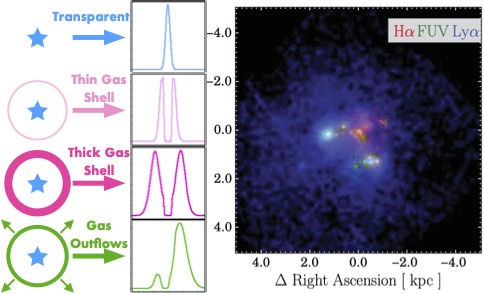Erik Solhaug's Website
Welcome to my corner of the cosmos! I'm Erik Solhaug, a PhD student in Astronomy & Astrophysics at the University of Chicago. I've been a graduate student in Chicago since the fall of 2022. I earned my Bachelor of Science in Astronomy and Physics: Comprehensive Physics at the University of Washington in June 2022. My research focuses on the evolution of the early galaxies, the transition of the universe from neutral to ionized in the process called "reionization", and the gaseous reservoirs that envelopes galaxies at any and all cosmic times. Through my research, I aim to shed light on the mechanisms in which ionizing photons escape the gaseous clouds surrounding galaxies and understanding how we can probe ionizing photon escape throughout cosmic time.
Check out my CV here:
(Last updated: March 30th, 2024)
Research Interests
Ionizing Photon Escape and Galaxies' Role in Reionization
After about half a billion years after the Big Bang, the hydrogen in the universe transitioned from a neutral opaque "soup" to an ionized transparent plasma. As the first stars turned on, their ultraviolet radiation ionized the neutral gas in the cosmos enabling light to shine freely through space. This so-called "reionization" of the universe is largely attributed to the massive stars produced in the earliest galaxies, and studying these galaxies is a key goal of several large new telescopes, e.g. the James Webb Space Telescope. How ionizing photons, or so-called Lyman continuum (LyC), escape the gaseous clouds around these galaxies likely depends on the structure and motions of the gas. However, distant galaxies are both faint and spatially unresolved making imaging their local structure impossible. Additionally, Observing ionizing photon escape beyond the nearby universe becomes increasingly challenging with higher redshift where the density of neutral hydrogen increases and ionizing photons are absorbed by the intergalactic medium. Lyman alpha, the brightest hydrogen spectral line, provides a powerful probe into the structure and motions of the gas surrounding galaxies beyond the nearby universe. Photons emitted as Lyman alpha must shift from their restframe frequency to escape the surrounding neutral hydrogen, revealing crucial information about the gas's properties and forming distinct Lyman alpha profiles. This resonant scattering property, while carrying with it several caveats, provides an avenue to interpret the physical, and its spectral shape may potentially trace the direct escape of LyC. In my research, I'm combining Lyman alpha radiative transfer simulations and neural networks to analyze observed spectral profiles of reionization analogs around cosmic noon (z~2). I am especially interested in the following questions:
- Can Lyman-alpha profiles be used to infer the ionizing escape of galaxies in the early universe?
- What conditions in the gaseous medium surrounding these early galaxies are needed to facilitate the escape of ionizing photons?

Gravitational Lensing
Gravitationally lensed arcs offer a uniquely powerful setting for examining the gaseous medium in galaxies beyond the nearby universe. These arcs manifest when foreground galaxy clusters distort and magnify background galaxies. This characteristic makes them well-suited for probing small-scale (~50 parsec) spatial variation in galaxies beyond the nearby universe which have e.g. unveiled a dynamic environment of stellar winds and continuous flows of high column density gas in Lyman-alpha emitting galaxies. Analyzing Lyman-alpha profiles in spatially resolved star-forming clumps allows us to comprehend the geometry and kinematics of the gas surrounding these sources. Resolving the true delensed structure of the source galaxy requires a solid understanding of the foreground mass distribution, usually of cluster-scale masses, especially when the source galaxy is located close to the critical curve. Therefore, my research involves parametric modeling of dark matter halos and subhalos from imaging data.
